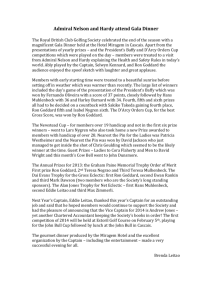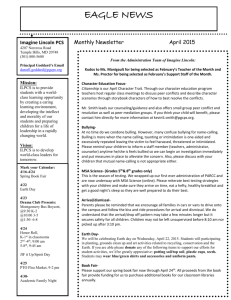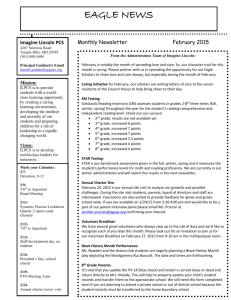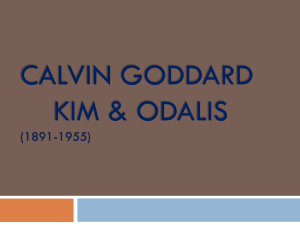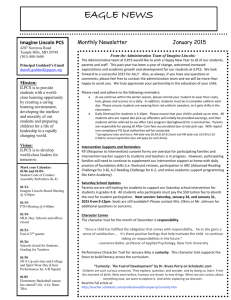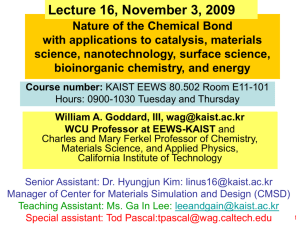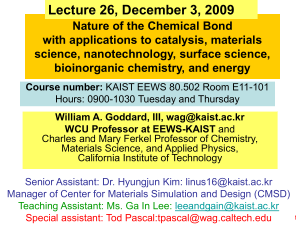Adventurous Life of John Goddard
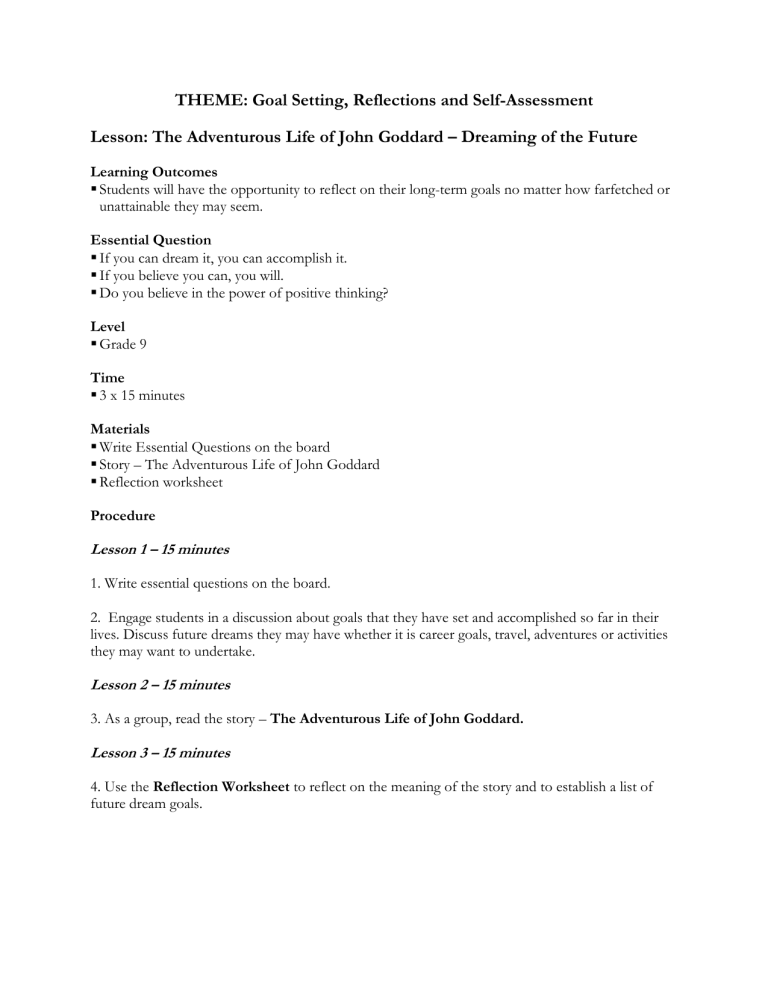
THEME: Goal Setting, Reflections and Self-Assessment
Lesson: The Adventurous Life of John Goddard – Dreaming of the Future
Learning Outcomes
Students will have the opportunity to reflect on their long-term goals no matter how farfetched or unattainable they may seem.
Essential Question
If you can dream it, you can accomplish it.
If you believe you can, you will.
Do you believe in the power of positive thinking?
Level
Grade 9
Time
3 x 15 minutes
Materials
Write Essential Questions on the board
Story – The Adventurous Life of John Goddard
Reflection worksheet
Procedure
Lesson 1 – 15 minutes
1. Write essential questions on the board.
2. Engage students in a discussion about goals that they have set and accomplished so far in their lives. Discuss future dreams they may have whether it is career goals, travel, adventures or activities they may want to undertake.
Lesson 2 – 15 minutes
3. As a group, read the story – The Adventurous Life of John Goddard.
Lesson 3 – 15 minutes
4. Use the Reflection Worksheet to reflect on the meaning of the story and to establish a list of future dream goals.
Extending/Follow-up
1. In a future lesson students will have the opportunity to write long-term and short-term career and life goals.
2. If students are interested in learning more about John Goddard, they can do an Internet search on his life. There is a website that gives an update on some of his most recent activities.
The Adventurous Life of John Goddard
Stuart McLean
When John Goddard was fifteen years old, he sat down one night with a red pencil, a blue pen and a yellow legal pad and made a list of things he wanted to do before he died.
His list began just the way you might expect:
Become an Eagle Scout.
Broad jump fifteen feet.
Make a parachute jump.
Dive in a submarine.
Learn ju-jitsu.
The more the boy wrote, the more his imagination took hold. The list soon left the realm of idle daydreams and entered the world of serious adolescent fantasy:
Milk a poisonous snake.
Light a match with a 22.
Watch a fire-walking ceremony in Surinam.
Watch a cremation ceremony in Bali.
And it didn’t stop there. As young Goddard continued his list, his vision expanded and showed signs of the grand adventurer he was going to grow up to be:
Explore the Amazon.
Swim in Lake Tanganyika.
Climb the Matterhorn.
Retrace the travels of Marco Polo and Alexander the Great.
Visit every country in the world.
The ideas poured onto the page and at some point took a sharp turn in tone. As Goddard added to his list, he displayed an academic sophistication well beyond his fifteen years:
Read the works of Shakespeare, Plato, Aristotle, Dickens, Thoreau, Rousseau, Hemingway,
Twain, Burroughs, Talmage, Tolstoy, Longfellow, Keats, Poe, Bacon, Whittier and Emerson.
Become familiar with the compositions of Bach, Beethoven, Debussy, Ibert, Mendelssohn,
Lalo, Milhaud, Ravel, Rimsky-Korsakov, Respighi, Rachmaninoff, Paganini, Stravinsky,
Toch, Tchaikovsky, Verdi.
Read the Bible from cover to cover.
Play the flute and violin.
When he put his pens down, there were 127 items on Goddard’s list.
Well. Yes.
We have all taken a stab at this sort of thing at one time or another. The extraordinary difference between John Goddard and the rest of us, however, is the unsettling fact that Goddard didn’t throw his list out. Nor did he chuck it into the bottom of a drawer. He kept his list in plain sight and set out to complete every item line by line. Today Goddard has check marks beside 108 of his original
127 goals. And that includes all of the items mentioned above.
Well that’s not exactly true. There are still thirty odd countries that he hasn’t visited. But he is working on that.
I first read about John Goddard in Life magazine when I was a teenager. It was in one of those articles at the back of the magazine in a section called the “Parting Shots.” The article stuck in my mind (How could I forget it?) and I always hoped I would get a chance to talk to him. Fifteen years later I sat down with his phone number in front of me and called him at his home in La Canada,
California. I wanted to talk to him, I explained, about the list I had seen so long ago in Life. I wanted to know if he was still working on it. Yes, he was. Did he remember what had inspired him to write it? John Goddard chucked.
I think what motivated me to write the list was listening to some family friends who were visiting with my parents. They had been over for dinner and were helping to clear the dishes. I was doing my homework in a little alcove, a sort of breakfast nook. The man of the family, a Dr. Keller, looked a time and said to my parents, ‘I’d give anything to be
John’s age again. I really would do things differently. I would set out and accomplish more of the dreams of my youth.’ That was the gist of his conversation – if only he could start over – and I thought, here’s a man only forty two years old, and he is feeling life has passed him by , and I thought, if I start planning now, and really work on my goals, I won’t end up that way.
Almost fifteen years have passed since John Goddard wrote out his life goals. He is now in his midsixties. But the day we spoke, he was busy preparing for a trip to the North Pole – one half of goals number 54, which is to visit both the North and the South poles. Another check mark. I spoke to
John Goddard for almost two hours, and we talked about many things. I asked him if he remembered the day he wrote the list.
I remember it vividly because it was such a rite of passage for me. It was a rainy Sunday afternoon in 1941. Until that time I really hadn’t crystallized all my ambitions and hopes and dreams. Writing them down was the first act in achieving them. You know, when you write something down with the sincere intent of doing it, it’s a commitment. A lot of us fail to do that. We don’t set deadlines and say, for example, by June of 1990 I’m going to have checked out in scuba, taken a rock climbing course and learned how to play the piano. The moment of writing it down is vivid in my mind because that was my formal commitment to that life list. And I felt I would give myself a lifetime to fulfill everything on it.
One of Goddard’s early challenges was an expedition by kayak down the longest river on earth – the
4,000 mile Nile. He was the first person in the world to travel the length of river from the headwaters to the Mediterranean. He took a bank loan to finance the trip and then paid off the loan by writing a book about his adventures. He sold the book on the lecture circuit. And that’s the way
he has made his living ever since. Goddard supports himself through his lectures, his books, and the sale of his films and tapes. He is not a wealthy man.
I asked him if he had ever been in any physical danger. He told me of the time he was lost in a sand storm in the Sudan, and couldn’t put up a tent because the wind was blowing so hard. But he couldn’t sit still because if he had stopped moving, he would have been buried alive. He told me about the time he had been shot at by river pirates in Egypt. Later I read that he had also been bitten by a rattlesnake, charged by an elephant, trapped in quicksand, been in more than one plane crash and caught in more than one earthquake.
Sometimes I go on and on about a hazardous drive my family and I had one winter between
Montreal and Toronto. It was snowing more than usual, the driving was tough, and there were a lot of cars off the road. There was also a service centre every fifty-odd miles, lots of snow-ploughs and plenty of people to help out if I had got in trouble. Nevertheless, when I tell the story of the drive I can make it sound pretty dramatic.
Imagine being able to start a story with “Exploring the Congo was difficult…”
Exploring the Congo was difficult. It took me six months and resulted in the loss of life of my partner, Jack Yowell from Kenya. Four hundred miles downstream we had a disaster when we both capsized on a raging stretch of rapids. It was the 125th set of rapids, and we were paddling fragile 60-pound, 16-foot kayaks. He got swept to the left and flipped over, too, and nearly drowned myself. I tried to fight to the surface and banged into the river bottom. The river was so turbulent I couldn’t really tell which way the surface was, and I was drowning because I was under the water an interminable time. I think the thing that saved me was the fact that I could hold my breath for three minutes in an emergency.
I was finally washed to calm water and ran along the banks desperately trying to find
Jack. I couldn’t see him anywhere. Then suddenly a box of matches came floating by, then his pipe, overturned kayak and aluminum paddle, but no Jack. It was very difficult to go on and travel the remaining 2,300 miles to the Atlantic. But we had promised one another if one of us did die on the upper river that the survivor would continue and finish the expedition for both of us. So I fulfilled that promise.
John Goddard still has a lot of things left on his list, but at age sixty-four he is in good shape and determined to keep at it. He does one hundred sit-ups every morning, works out on cables and weights and rides a stationary bike at least six miles a day.
The Adventurous Life of John Goddard—Reflection Worksheet
1.
Scan the article to find advice that John Goddard gives about setting and achieving goals. Find three different pieces of advice and record them.
2.
John Goddard had 127 items on his list of things he wanted to accomplish before he died. Make you own list with a minimum of 20 items. Select three goals from your list that you feel are attainable this school year. For each of these goals, explain how you plan to achieve it.
Part A – Goals/Future Dreams
1. _______________________________ 11. _______________________________
2. _______________________________ 12. _______________________________
3. _______________________________ 13. _______________________________
4. _______________________________ 14. _______________________________
5. _______________________________ 15. _______________________________
6. _______________________________ 16. _______________________________
7. _______________________________ 17. _______________________________
8. _______________________________ 18. _______________________________
9. _______________________________ 19. _______________________________
10. ______________________________ 20. _______________________________
Part B – Explain how you plan to achieve three goals this school year.

